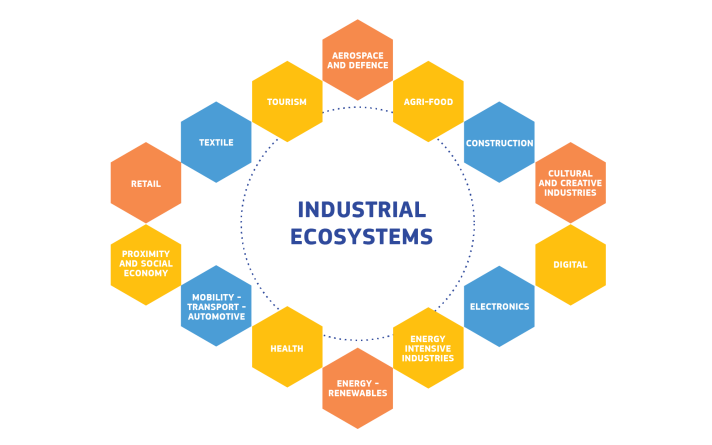| Ecosystem | Staff working document with scenarios | Public consultations | Transition Pathway | Public event | Call for commitments and initiatives |
|---|---|---|---|---|---|
| Tourism | 21 June 2021 | Closed on 15 September 2021 | 4 February 2022 | EU Industry Days - 8 February 2022 | Launched |
| Chemicals | n.a. | No formal public consultation | 27 January 2023 | - | Launched |
| Metals sectors | n.a. | No formal public consultation | 19 March 2025 | - | To be launched |
| Mobility | 24 January 2022 | Closed on 29 April 2022 | 26 January 2024 | Round table event - 29 February 2024 | Launched |
| Construction | 14 December 2021 | Closed on 28 February 2022 | 15 March 2023 | High Level Construction Forum meeting – 15 March 2023 | Launched |
| Proximity and Social Economy | 8 December 2021 | Closed on 28 February 2022 | 14 November 2022 | Launch event - 14 November 2022 | Launched |
| Textiles | 30 March 2022 | Closed on 15 June 2022 | 6 June 2023 | - | Launched |
| Retail | 28 July 2023 | Closed on 26 September 2023 | 12 March 2024 | High-level conference on retail - 12 March 2024 | Launched |
| Agri-food | 24 July 2023 | Closed on 19 September 2023 | 11 March 2024 | Open Food Conference - 11 March 2024 | Launched |
| Aerospace | 26 July 2023 | Closed on 3 November 2023 | 7 June 2024 | ILA Air Show in Berlin – 7 June 2024 | Launched |
Other strategies
| Ecosystem | Staff working document with scenarios | Public consultations | Transition pathway | Public event | Call for commitments and initiatives |
|---|---|---|---|---|---|
| Energy Intensive Industries | 21 September 2021 | Closed on 26 November 2021 | Transition pathway covered by: Masterplan for a competitive transformation of EU energy-intensive industries (2019) | - | - |
| Renewables | Transition pathway covered by: REPowerEU (2022) | ||||
| Health | Transition pathway covered by: HERA (2020), the revision of the pharmaceutical legislation (2022), the IPCEI for health (2022) and the security of medicines supply under the pharmaceutical strategy for Europe (2020) | ||||
| Creative and Cultural Industries | Transition pathway covered by: European media action plan (2020) | ||||
| Digital | Transition pathway covered by: The digital decade compass and policy programme (2021) | ||||
| Electronics | Transition pathway covered by: The EU Chips Act (2022) | ||||
| Defence Industry | 26 July 2023 | Closed on 3 November 2023 | Transition pathway covered by: European Defence Industrial Strategy (26 February 2024) | - | - |










